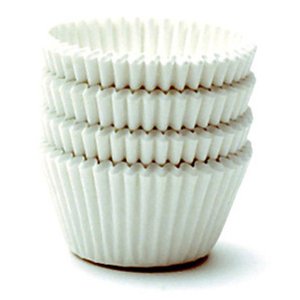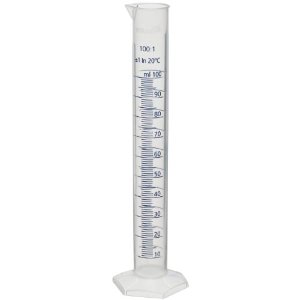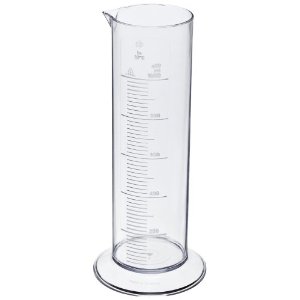How can I measure the right amount of acid dye to use for a particular color?
Name: Bobbie

Linda Knutson's
Synthetic Dyes for Natural Fibers

White paper bake cups
White paper disposable muffin tin liners make good laboratory weigh dishes for weighing out dye powder
Country or region: Michigan
Message: I'm trying to custom match wool/nylon sock yarn to a specific tartan. I use ProChem dyes, and they were kind enough to suggest a combination of 0.85% Flavine Yellow, 0.1% Brilliant Blue, and 0.05% Bright Orange. I am so lost!! I usually measure and achieve good results, but this is for socks for a national champion and I'm not sure what to do with this. Please point me in the right direction on measuring and mixing. I do have a decent scale, and my daughter is a chemical engineering major - she'll be on hand to help. I have reviewed your website and found some applicable posts, but I'm not sure how to combine these suggestions. Thanks so much for any assistance you can provide.
The numbers that ProChem gave you are meant to be used for weight measurements, as compared to the dry weight of the fiber you are dyeing.
For example, if you are dyeing 200 grams (about 7 ounces) of sock yarn, for the Flavine Yellow, you will want to use 200 times 0.85 divided by 100. (Percent means "divided by 100".) That works out to 1.7 grams. For the same 200 grams of fiber, you would use 0.2 grams of Brilliant Blue, and 0.1 grams Bright Orange.
Weigh your fiber so that you can use a calculator to figure out the exact weight of dye needed. If you are dyeing one pound of yarn, that is the same as 454 grams, which would require 3.9 grams of Flavine Yellow, 0.45 grams of Brilliant Blue, and 0.22 grams of Bright Orange. (454 grams of fiber, times 0.85 divided by 100, works out to 3.859 grams, which rounds off to 3.9 grams of dye powder.)
The next problem is that, even if you have a good scale for weighing out your dye, you do not have a scale capable of accurately weighing such small quantities. The answer is to prepare a dilution of your dye in water, so that you can measure out just a small part of it, so as to get just the right amount. You will need some reliable laboratory-type tools for measuring the volume of liquids that are required. Kitchen measuring cups and spoons tend to be inaccurate enough that they could cause difficulties in measuring the amounts you need.
I would start with a plastic graduated cylinder in each of three sizes: one liter, 500-milliliter, and 100-milliter. To dissolve your acid dye, place about 300 to 500 milliliters of boiling water into a glass or stainless steel container, such as a one-quart Pyrex glass kitchen measuring cup. While rapidly stirring the water with a stainless steel spoon or a glass stirring rod, gradually pour in 10 grams of acid dye powder, which you have already weighed out using your scale. (Use a piece of waxed paper on your scale to measure the dye powder onto, or a paper cupcake liner or a disposable plastic weigh boat.) After the dye is completely dissolved in the water, so that there are no particles of dye powder suspended in the water and there is no dye at the bottom of the container, pour the mixture into your graduated cylinder. Add more water to bring the total up to exactly 1000 milliliters, which is one liter. This is a 1% stock solution. Some acid dyes can dissolve well at concentrations up to 10% (100 grams per liter), but some cannot dissolve well at more than 1%.
Store this acid dye stock solution in clearly labeled glass or plastic bottles with screw-on caps. Use tape or self-adhesive labels to write on, since permanent marker will be too difficult to read on a bottle containing dark dye. The stock solutions should stay good for six months at room temperature. Be careful, before using it, that none of the dye has settled out on the bottom of the container; if it does, you will need to reheat and stir or shake until the dye has dissolved again. If mold forms, you will need to filter it out before use.
Given a 10-grams-per-liter stock solution, which is a 1% stock solution, you can then easily measure out just as much dye as you need by volume, instead of weight, and still get the precision and accuracy of having weighed your dyes out. (Measuring dye powder by volume, using a teaspoon, gives less reproducible results, because dyes are standardized and sold by weight, not by volume.) Ten milliliters of this stock solution contains 0.1 grams; a hundred milliliters contains 1.0 grams. Going back to the calculations made above, to measure out 3.9 grams of Flavin Yellow, you will need 390 milliliters of a 1% stock solution. For the 0.45 grams you need of Brilliant Blue, if you're dyeing one pound of yarn, you will need to measure out 45 milliliters of a 1% stock solution.
(Use the smallest size graduated cylinder you have that will hold a given volume. Measure the 390 mls in a 500-ml cylinder, and measure the 45 ml in the 100-ml cylinder. Don't measure a small volume like 45 ml in the large 1-liter cylinder, because the measurement will be less precise.)
I will assume that you are using ProChem's recipe for Immersion Dyeing Wool using WashFast Acid Dyes [PDF]. Note that this recipe is for one pound, or 454 grams, of yarn. For larger or smaller quantities, you can scale the other ingredients up or down by the same amount. You will need to add salt, Synthrapol, and some sort of acid such as distilled white vinegar, or citric acid powder, as described in the recipe.
For more details on how to prepare stock solutions of dye, and how to use the metric system if it is new to you, I strongly recommend Linda Knutson's book, Synthetic Dyes for Natural Fibers, which is long out of print but still available used online for less than twenty dollars.
To buy plastic graduated cylinders, you can look at an online laboratory supplies company, such as Ward Scientific, or American Science and Surplus. Amazon now carries a reasonable assortment of labware, which makes it very easy to find.
(Please help support this web site. Thank you.)
(Please help support this web site. Thank you.)
Posted: Tuesday - April 26, 2011 at 04:22 PM
Follow this blog on twitter here.
Quick Links
- All About Dyes & Dyeing Top -
- Top of this blog -
- FAQ -
- The Dye Forum -
- How to Tie Dye - How to Batik -
- Books - Toys - Plants -
- Top of this blog -
- FAQ -
- The Dye Forum -
- How to Tie Dye - How to Batik -
- Books - Toys - Plants -
More in this category:
- -
Statistics
Total entries in this blog:
Total entries in this category:
Published On: Aug 29, 2012 02:49 PM
Total entries in this category:
Published On: Aug 29, 2012 02:49 PM

